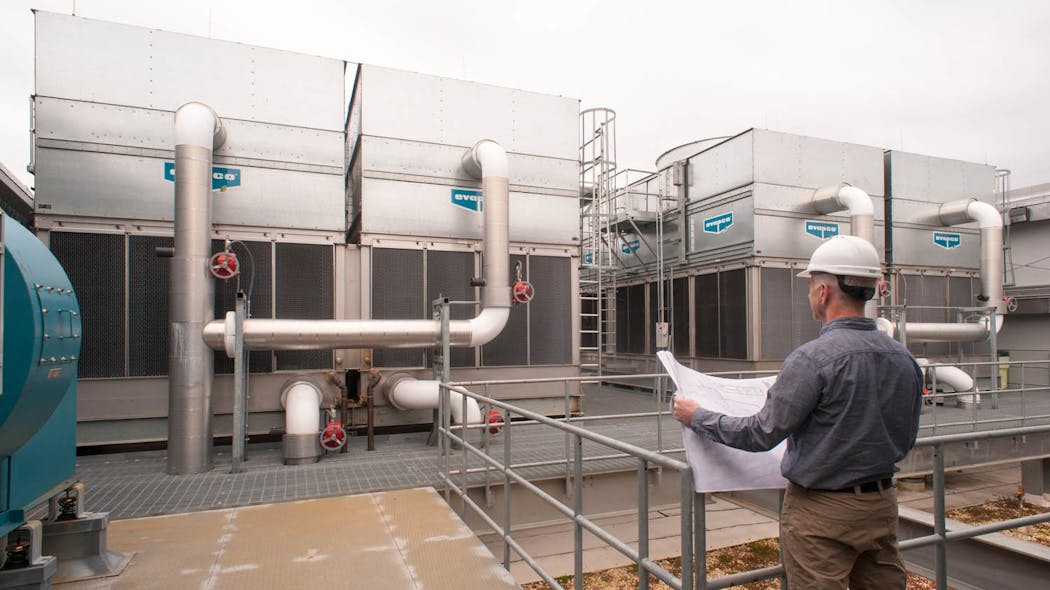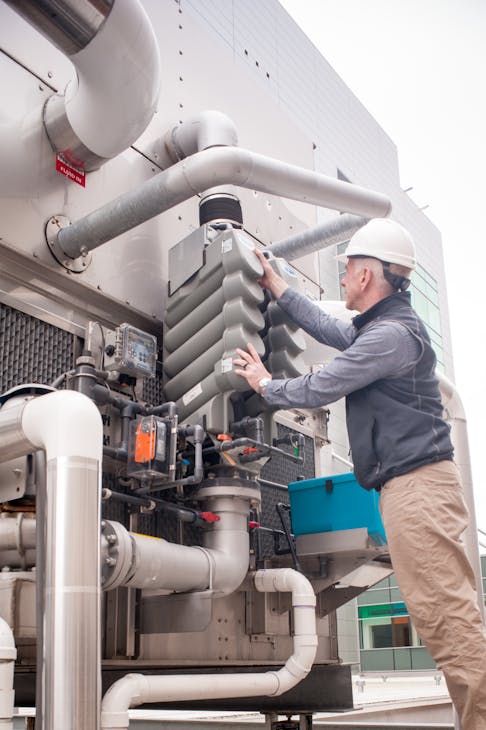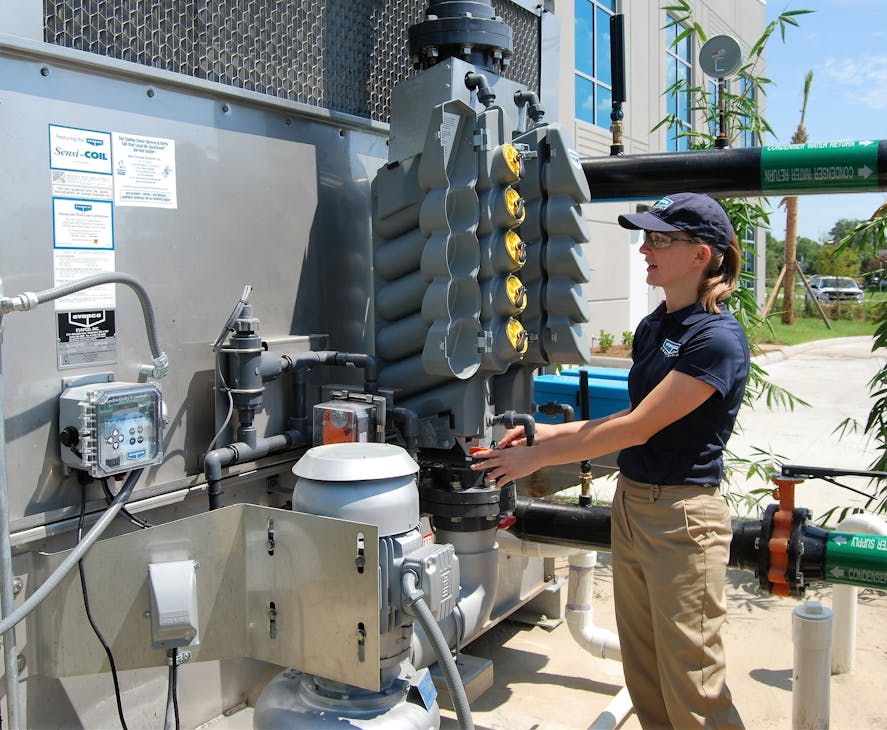For decades, cooling towers have provided the most efficient means of cooling large commercial buildings or industrial process loops by providing the lowest operating temperatures available.
Yet, through the years, water-based cooling systems have evolved dramatically. Terminal units, chiller plant components, cooling towers (as well as fluid coolers) and the controls that tie them together have all made strides in efficiency, controllability, heat transfer and water conservation. The end user, owner, installer and maintenance personnel all benefit.
Most, if not all these advancements reduce the maintenance required by cooling towers and closed-loop fluid coolers. Technological advancements have reduced and streamlined maintenance needs and associated costs in terms of dollars and equipment downtime.
“Many facets of tower maintenance are still best conducted manually and with a predetermined schedule, but automation and autonomy have found a place in cooling tower and closed-loop fluid cooler systems,” said Kevin Hetman, who operates Chesapeake Systems’ Mr. GoodTower division. “Mr. GoodTower’s function is to repair cooling tower systems more than to maintain them, so we’re very familiar with the fallout of ineffective maintenance. Suffice to say, if more elements in the maintenance process are handled automatically, the healthier the system will be.”
The bulk of all cooling tower maintenance tasks are aimed at controlling scale, corrosion and microbial growth within various parts of the system. Eliminating or minimizing these concerns reduces the time and effort required to maintain nearly all the components of a cooling tower.
Advancements in cooling tower maintenance can be broken into these key subcategories: routine media replacement (if applicable), checking structural integrity, system function diagnostics, water treatment, automated controls and, in some cases, reducing wet cooling operation via hybrid tower design.
Reducing manual water treatment
The level of maintenance that a specific cooling tower requires is largely determined by the quality of makeup water available at the site, and the way system fluids are treated.
“High hardness and alkalinity are the primary water quality concerns,” said Brandon Punt, sales manager at Jaytech Inc., one of the nation’s largest water management solutions providers. “Microbial growth results from exposure to the atmosphere if water treatment isn’t handled correctly. Proper, site-specific water treatment addresses all these factors.”
In recent years, both makeup and recirculating water treatment have been simplified. EVAPCO, a global manufacturer of cooling towers, fluid coolers and dry and adiabatic coolers has addressed the need for streamlined water treatment.
“Our three most recent water treatment developments include solutions for both makeup water and recirculating water, all while greatly reducing the labor and mess that can be associated with conventional chemical treatment,” said Brett Alexander, applications engineer at EVAPCO.
The EVAPCO Water Saver (EWS) is a pre-treatment system engineered to improve water efficiency for evaporative cooling equipment. With an integrated control panel, EWS uses capacitive deionization technology to reduce dissolved ion concentration, lowering the makeup water’s conductivity prior to use in an evaporative cooling system.
Pre-treating the raw makeup water can reduce ion concentration by 50%, allowing cycles of concentration to be safely doubled, thus reducing the blowdown from the unit. This provides water savings and reduces the amount of treatment chemicals needed for recirculating water. The EWS system turns on automatically when the tower control system calls for makeup water.
Recirculating water treatment can be improved, too, where water quality at the site permits the use of non-chemical treatment. For instance, systems such as Pulse-Pure use pulsed electric fields to solve all three critical water quality challenges — hardness, alkalinity and microbial growth — typical of water-cooled systems.
With this technology, recirculating water from the evaporative cooling system passes through a pulse chamber where it is exposed to alternating high and low frequency electric fields. This impacts both the surface charge of small, suspended particles and free-floating microbial organisms found in cooling water. With a Pulse-Pure system as the sole source of water treatment, all the logistics and labor associated with chemical treatment are eliminated.
When chemical treatment is required, EVAPCO’s Smart Shield solid chemistry treatment system provides a complete, reliable alternative to liquid chemical systems, greatly simplifying chemical water treatment.
By using solid chemistry, the system eliminates the potential for liquid spills and greatly reduces shipping, handling and storage of chemicals. These systems simplify installation and commissioning, and minimize the floor space required in the mechanical room for water treatment.
The use of solid chemistry also reduces the risk of overfeeding chemicals. Liquid chemicals, such as oxidizing biocides and acids, can accelerate corrosion in the unit if overfed.
Controls
Beyond controlling water treatment systems, a modern BAS can be integrated with the cooling plant to provide a variety of maintenance benefits.
When multi-cell cooling towers are installed, the BAS can be programmed to rotate the lead and lag role of any number of cells. At part-load conditions, one or more of the cells in a system operate while others remain off. If the order in which these cells come online is not rotated, there would be great disparity between the runtime hours across the cells. Balancing operating time between cells simplifies preventative maintenance, such as greasing bearings, checking belt tension, insulation testing of motors, etc.
One autonomous function of the BAS is to recirculate water within the tower on pre-determined intervals.
“Throughout the shoulder seasons, it’s not uncommon for cooling towers to remain idle for days at a time,” said Alexander. “This increases the risk of microbial growth. We generally suggest that an idle cooling tower should recirculate for about one hour per day. This exposes the fluid within the tower to the water treatment system being used.”
A BAS frequently incorporates other data collection and automation functions, such as water level metering, activation of makeup water treatment components and monitoring of water conductivity. The blowdown of the cooling system is automated around the conductivity setpoint. All this information can be accessed remotely by the owner or service company to conduct maintenance.
Because the maintenance requirements of a water-cooled system is determined largely by water quality and treatment, using less water will inherently mean less maintenance. That, along with water conservation, is the reason some manufacturers have begun offering a variety of hybrid cooling solutions.
Hybrid designs
“If you have equipment that can provide wet and dry cooling, one of the benefits is minimizing scale buildup and reducing spray pump runtime hours,” said Matt Shank, product application manager at EVAPCO. “And the basin can be drained over the winter, when dry operation is sufficient to handle the cooling load.”
These hybrid systems remain in dry cooling mode until the temperature set point can no longer be met. While in dry mode, no water is used, thus plume is eliminated, as are water consumption and sewage expenses.
In this mode, process fluid enters one of two, closed-loop, dry-cooler coils. These coils have a high density of fins for better heat transfer than a bare tube coil. When the fan activates, air is drawn upward through the louvers and across the coils. As the air passes over the coil, a portion of the load is dissipated to the atmosphere via the tube walls and fins through sensible heat transfer. The warm process fluid then exits the first coil and enters the second coil, where the remaining load dissipates through sensible heat transfer.
When the temperature set point can no longer be met, the unit switches to evaporative (wet) mode, which uses both evaporative and dry cooling simultaneously to significantly increase cooling capacity. Because the unit’s dry coil dissipates some of the load before system fluid reaches the wet coil, less water is used than in a conventional cooling tower design.
Mitigating vibration
Mitigating vibration from a cooling tower’s moving parts is also a critical maintenance function to help extend equipment life. The sources of vibration can include natural resonance, faulty bearings, misalignment of rotating components or rotating components that are out of balance.
Rather than simply isolating the building and components from vibration, a proper maintenance plan should seek to detect vibration, allowing maintenance personnel to fix the underlying issue before damage occurs. If left unchecked, vibration has the potential to shorten component life (bearings, fans), or cause catastrophic equipment failure. Vibration can also be transmitted through the building structure, creating a nuisance for occupants.
To detect vibration early, cut-out switches, which de-energize fan motor at unacceptable vibration levels, should be installed. Monitoring devices can be used to measure vibration levels and report trends to the BAS. A common, effective method is to use general-purpose accelerometers secured to fan motor and fan shaft bearings.
As automation and autonomy proliferates across all sectors of the heating and cooling industry, large cooling tower and closed-loop fluid coolers have not missed the trend. Because of the advancements made to these critical pieces of equipment, commercial and industrial cooling systems have become even more economical to own and operate.





